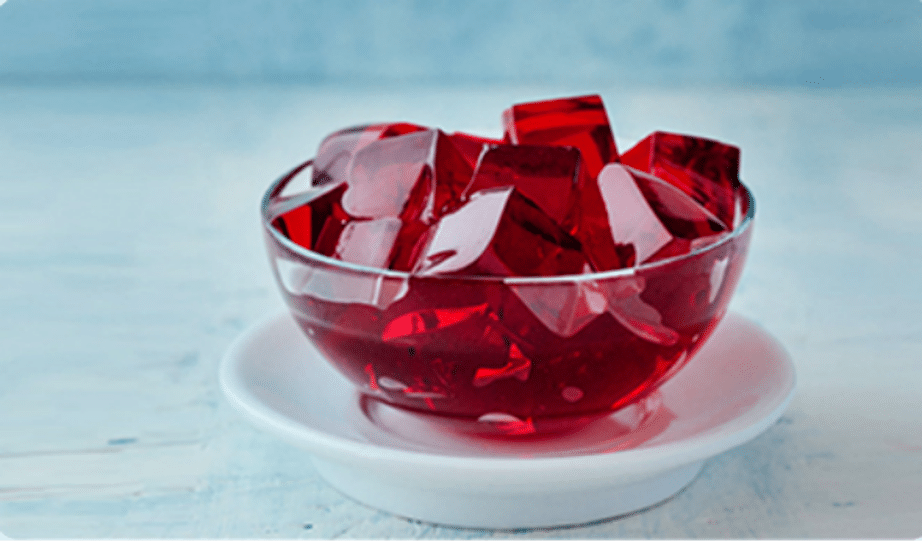Gelatin, derived from collagen, is a protein that serves multiple purposes in the culinary realm. It is utilized as an emulsifier, stabilizer, clarifier, and gelling agent. In the culinary world, gelatin is highly regarded for its transformative properties, enhancing dishes with a delightful texture and creamy consistency.
But gelatin isn’t simply used in the food industry; it also has wide applications in the pharmaceutical and cosmetic industries. To better understand how an industry can benefit from gelatin, you should first study the types of gelatin.
Gelatin Types Based on Application
We can categorize different types of gelatin into three major categories based on their applications:
1. Edible Gelatin
Edible gelatin is used in the food industry mainly due to its gelling and glazing properties. This gelatin type is derived from cows’ and pigs’ tendons, bones, ligaments, and connective tissue. This protein product is safe for human consumption if the manufacturing process adheres to safety guidelines.

2. Pharmaceutical Gelatin (Gelatin in Medicine)
Pharmaceutical gelatin is used in the medical and pharmaceutical industry as it is well tolerated inside the body. Gelatin is the main component of the hard and soft capsule shells widely used in the medical industry.
Like edible gelatin powder, pharmaceutical types of gelatin are also derived from animal connective tissue and bone, making it safe for human consumption.

3. Other Applications of Gelatin
Another significant type of gelatin is the industrial gelatin used in various other industries, such as cosmetics, photographic films, paper coatings, paints, and adhesives. Industrial gelatin is manufactured as a by-product of the meat and leather industry. Unlike edible gelatin, this gelatin is nowhere near as refined, making it unfit for human consumption.
Factors to Consider When You Buy Gelatin
Now you know the main types of gelatin, it is time to select the right gelatin. When choosing the suitable gelatin, there are many factors to consider. These include the following:
§ Gelatin Source
Always make sure you know where the gelatin has been derived from. Remember, industrial gelatin is not safe for human consumption. Similarly, pharmaceutical gelatin may be safe for consumption, but it won’t offer the same gelling effects you would desire if you were using them in your culinary practice.
To avoid this, you should ensure the gelatin brand lists the animals used to derive the gelatin even better if they list what part of the animals were used.
§ Bloom Strength
Some gelatins tend to be stronger than others. Their strength is usually indicated by their “bloom strength,” which can be between 30 and 300 blooms. Typically, 150-220 is considered a medium bloom, whereas a >220 is considered a high bloom; any lower than 150 is a low bloom.
§ Viscosity
Viscosity is a measure of how viscous the gelatin is or a measure of its “thickness.” The viscosity of gelatin can vary according to its specific formulation, bloom strength, and temperature. In general, gelatin with a higher viscosity will deliver you chewier jellies and foods compared to gelatins with lower viscosity.
§ Particle Size
The particle size of gelatin or the particle size refers to the size or the diameter of the solid particles in gelatin. Gelatin typically has a particle size ranging from 8 to 200 mesh, with 200 being the indicator for the finest particles.
A smaller mesh will dissolve more readily into a solution, whereas coarser particles will dissolve much slower. Similarly, smaller particles will give you a stronger gel structure, making it more suitable for gelatin-based products.
§ Form (Such as Sheets, Granules, or Powder)
Finally, gelatin comes in three main forms: sheets, granules, and powders. Gelatin sheets come in varying sizes of thin, transparent sheets. Granules consist of small, irregularly shaped solid granules. Powdered gelatin consists of gelatin in a powdered form.
Gelatin powder and granules tend to disperse more easily through your dish; in some cases, they don’t even require prior rehydration with water. On the other hand, sheet gelatin delivers a clearer, transparent product than powdered gelatin.
About Funingpu
Now you know the various types of gelatin, you can make a decision for your needs. If you are looking for high-quality gelatin, Funingpu should be your choice. As one of the leading providers of collagen peptides and gelatin, including both edible and pharmaceutical gelatins, Funingpu has been leading the gelatin manufacturing industry for over 30 years. They excel in the manufacturing of edible and pharmaceutical gelatin for applications in the food and pharmaceutical, and nutraceutical industry. They provide main types of gelatin, including edible gelatin and pharmaceutical gelatin as well as collagen peptides.
Their gelatin products are manufactured using strict quality control protocols, state-of-the-art manufacturing facilities, and the latest manufacturing technologies to deliver safe, pure, and quality results. For more information, check out the Funingpu website.

